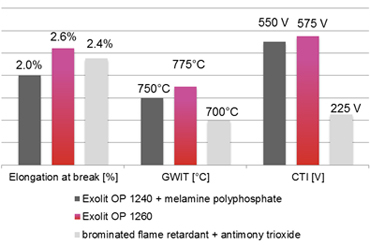Preview K-Show: New Phosphinate Solutions for Hot and Humid Polyamides, Tough Polyesters
Exolit OP products are widely used in polyamides and polyesters, mainly in reinforced compounds. Polyamides combine stiffness and dimensional accuracy with high strength, toughness and very good electrical insulation properties. The most common polyamides are PA 6 and 66. Semi-aromatic polyamides are used for high temperature applications. Recently, new bio based polyamides have been launched as well. Various flame retardant grades can be found in the product ranges of PA suppliers and different kinds of flame retardants are commercially used. One challenge for flame retardants is the high processing temperature of polyamides, which can reach up to 340°C. During the processing step polymer degradation, formation of decomposition products and discoloration can occur in case of insufficient thermal stability of the additive.
Polyamides achieving the UL 94 V-0 classification down to 0.4 mm thickness and CTI values of 600 Volt can be made with Exolit OP products. The newly developed Exolit OP 1400 (TP) provides enhanced thermal stability making it especially suitable for high processing temperatures and compounds which are injection molded into complex cavities. Exolit OP 1400 (TP) extends the application range of flame retarded polyamides in hot and humid environments. The dosage of Exolit OP 1400(TP) is in the same range as for the well-known Exolit OP 1312 and 1314. Compound properties like tensile and impact strength, CTI and heat aging are comparable as well. Clariant has already built up a semi-commercial plant for Exolit OP 1400 (TP) at its Knapsack site in Germany.

Thermoplastic polyesters obtained from aliphatic glycols and aromatic dicarboxylic acids are an important group of engineering plastics. The largest volume is represented by polyethylene terephthalate (PET) and polybutylene terephthalate (PBT). PBT has a lower melting point and heat distortion temperature than PET, but is a better electrical insulator and can be moulded at lower temperatures. Thermoplastic polyesters are often used for insulating parts in the electrical and electronic industry and are competing with polyamide 6 and 66. PBT has good dimensional stability, thermal and chemical resistance. The strength and stiffness of reinforced PBT allow its use in thinner wall sections than is possible with unreinforced materials. The high heat deflection temperatures of reinforced grades make PBT able to perform in high temperature environments. The organic phosphinate Exolit OP 1240 is often used in combination with additive synergists as a means to address both fire safety and the performance requirements for specific applications. Thus, the use of synergists enables the design of tailor-made flame retardant solutions for polyesters. A wide range of synergists has been tested in Clariant’s Technical Center in order to improve the fire safety as well as the mechanical and electrical performances of polyester compounds used in injection moulding. As a result, Exolit OP 1260 (TP) was developed, a new synergistic blend achieving UL 94 V-0 even at 0.4 mm while enhancing melt flow and mechanical properties of polyester compounds. Exolit OP 1260 (TP) is commercially available already.

Graph showing the excellent performance of Exolit OP 1260 in PBT GF 30 UL 94 V-0 Compounds: mechanical (best elongation at break), flammability (best glow wire test, GWIT, performance) and electrical properties (best comparative tracking index, CTI. Source: Clariant data.

